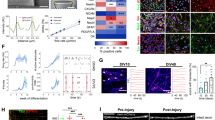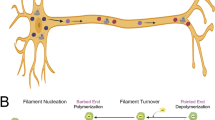Abstract
It was earlier established that one of the primary morphopathological consequences of experimental traumatic brain injury is a dramatic reduction in the distances between the neurofilaments (cytoskeletal compaction) inside a number of axon segments that appear to be randomly distributed among normal axons in an otherwise undamaged parenchymal environment. The present results demonstrate that the cytoskeletal compaction instantly induces argyrophilia, thereby rendering possible selective visualisation of the affected axon segments for light microscopy through use of a special silver staining method. On combination of this method with electron microscopy, it was revealed that the cytoskeletal compaction is completed in much shorter times and extends to much longer axon segments than previously assumed.
Similar content being viewed by others
Author information
Authors and Affiliations
Additional information
Electronic Publication
Rights and permissions
About this article
Cite this article
Gallyas, F., Farkas, O. & Mázló, M. Traumatic compaction of the axonal cytoskeleton induces argyrophilia: histological and theoretical importance. Acta Neuropathol 103, 36–42 (2002). https://doi.org/10.1007/s004010100424
Received:
Revised:
Accepted:
Published:
Issue Date:
DOI: https://doi.org/10.1007/s004010100424




